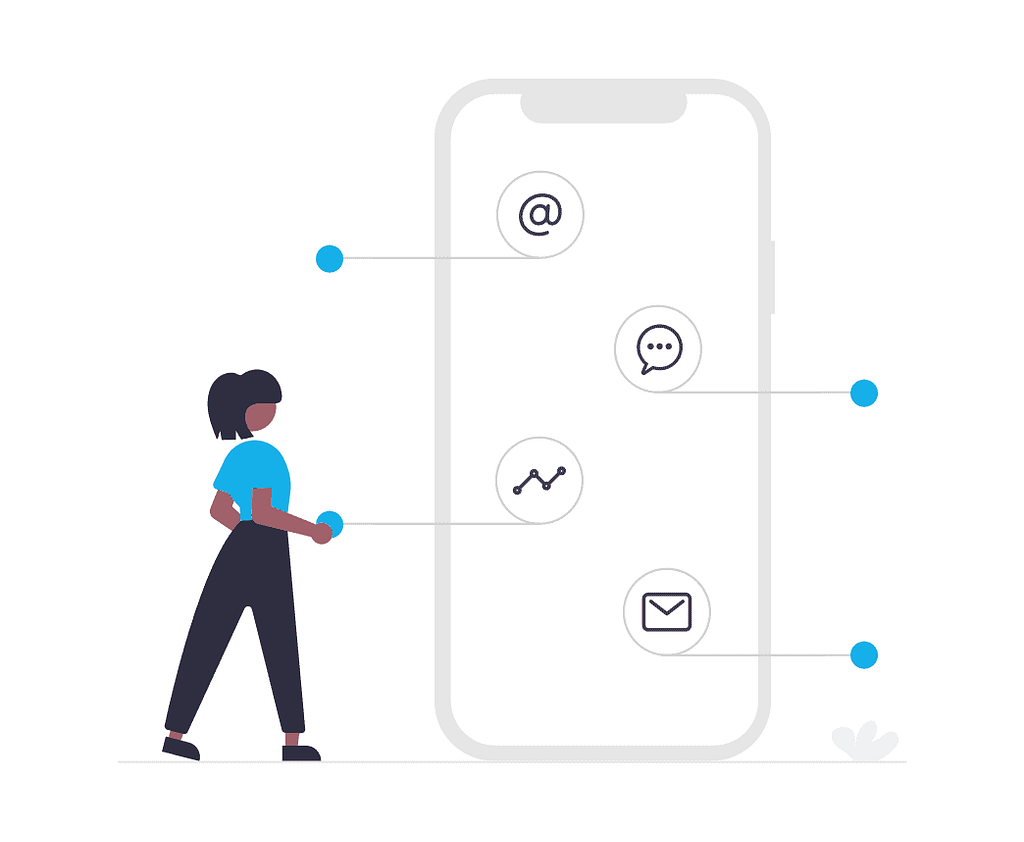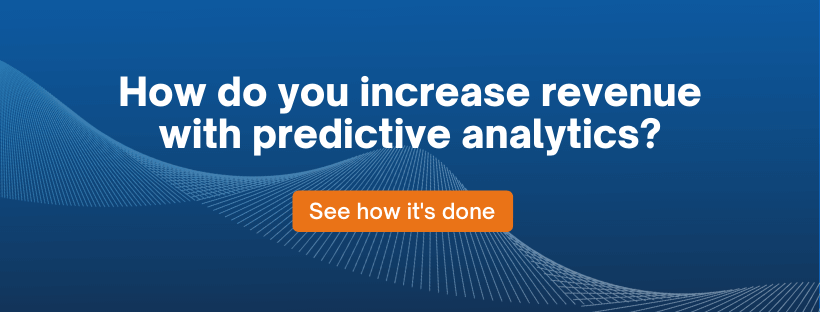The sales department is undoubtedly an essential part of any organization. Without the salespeople, deals can’t be closed. Period. It’s clear that sales processes need to be efficient, so you can utilize the time of your representative the best you can – and yet, so many companies fail to create good processes that will be clear, understandable, and bring value.
What are some of the biggest issues with the sales processes? Let’s have a look at 3 most common problems and the ways AI can help address them.
Talking to the wrong people
Consumers do their homework. Do you? Not knowing your customers is a common mistake in marketing and sales activities. And it’s a serious mistake, let me tell you.
Your prospective customers will most likely research you before signing a deal. Let’s look at an example of a telecom company. There’s a wide range of providers on the market, and the basic offering is very similar. In a standard subscription-based contract, you get unlimited calls and messages, mobile internet, and that’s all. If we’re only looking at these basics, the difference between providers will be price. But then, there are more sophisticated offers, too. You might get your subscription with a device – and the selection of these will be different for each provider. You might get additional services for free or at a lower price: Netflix, HBO, Spotify, etc. Thanks to that, telecoms can now give us better offers with more of what we need. Oh wait, but can they?
Imagine you’re a customer now. You surely are a customer of some telecom anyway, so it’s not that hard. A sales representative calls you and tells you about this great offer they have, time-limited, awesome price. It comes with a Netflix subscription. Cool! The thing is, though, that this offer is the same for everyone, and while that was fine some time ago, we now are looking for a more personalized approach and need more flexibility. So the plan’s frames may not be working for you. You need more internet on your mobile, a better device, or a different Netflix subscription. But the company’s plan may not keep up with your needs.
Now, telecom providers (given that you’ve granted your consent for the processing of data from your phone) can have a look into what you like. This way, your current provider will not call you and say “Hey, we have this cool offer for new customers” – when in fact you’ve been their customer for a decade – they will call you and say: “I see you don’t need this much internet transfer, but instead you could use a bigger plan for international calls, and a Spotify subscription. How does that sound?”.
When you target the right people and you give them what they need, the sales process is a whole different story. Not painful at all. Yes, it is possible to make a sale over a phone call and keep the customer happy. On the other hand, there’s always a group of people who find targeting and personalization (put simply: the fact that you’re analyzing the data they generate) creepy. And avoiding creeping people out will be the task of your sales staff. Personalization should be about caring, adding a human touch, and not scaring people away.
Letting your customers go
Did you know that acquiring a new customer costs you 5 times more than retaining an existing one? Though customer retention is not strictly a sales task, it has a big impact on the company’s revenue. Maximizing customer lifetime value should be as important as getting new deals, yet somehow it seems like your value as a customer goes down drastically after you’ve signed the deal. But a customer once won is not a customer forever.
When you “win” a customer and take good care of them, you’ll increase their CLV – they will renew their contracts or buy other products or services from your offer. However, overlooking a customer is risky and expensive. The probability of upselling to an existing customer is 65%, while the chances of selling to a new prospect are only 13%. That’s a huge difference!
When thinking on boosting your revenue, don’t just focus on new deals, improve the experience of your existing customer base to build loyalty, encourage them to stay with you for longer and buy more. Attracting new customers is awesome – but do so on top of retaining those that are already with you.

Pricing – balance conversion and margin
When the market is saturated, pricing is often the factor that companies choose to play with to generate more sales. If what a company is offering is generally nothing special (since all competitors offer the exact same thing), the reasonable thing to do is give the same value for less money. But again, what was rather simple in the past when it was easier to monitor the market, has become increasingly difficult with the growing competition, their various offers and pricing strategies. Especially retailers can experience difficulties adjusting their prices right with constant changes and competition both offline and online.
You probably know that bad pricing comes at a price (bad pun, but true!). A price that is too high prevents people from buying your product or service. While a high price may be a good filter for your target group (think: Ferrari – it just doesn’t have to be affordable), the filter may sometimes be too strict and stop you from expanding. A low price causes you to lose that valuable profit margin. Surprisingly a price that is perceived as too low will also prevent customers from buying – there’s something wrong with this product if it’s that cheap! Finding the right balance between too high and too low at a given level is a tricky task – what may be a great price for one client (shouldn’t you quote more?) may be way too high for another. Having a general price list for all your clients means that you always leave some margin untapped and some potential clients not converted.
Artificial intelligence for a sales boost
A lion’s share of what can be improved with AI for sales and marketing processes lies in optimization. There is a number of ways AI helps sales teams: processes can be shortened, sped up, automated to improve the overall efficiency of the team. When it’s hard to tell which prospect is most likely to become a deal, use lead scoring. When working on customer retention, use churn prediction and target those who were just about to leave. When you don’t know how to create more personalized offers, a recommender system is the answer. Or when you’re struggling with adjusting your prices just right, go with dynamic pricing.
That all sounds good – seems like all problems have been solved – but how do these work?
Lead scoring
For long, lead scoring had been quite intuitive and based on a representative’s professional experience Today, however, lead scoring is completely data-driven. AI helps the sales teams utilize the data about existing customers to predict the likelihood of a lead to convert into a paying customer. Predictive analytics will automatically analyze data (such as demographics and behavioral data) and compare it against the data set of the same information concerning existing customers to figure out whether the lead really has a need for your product or service, at what stage of customer journey the lead is and what their timeline-to-buy looks like, and even which salesperson is most likely to close given deal.
Churn prediction
AI-powered churn prediction shows which customers want to stop using your services. Even though churn reduction is not directly the salespeople’s job – it’s usually the retention department that takes care of it, it is a cost-efficient way of boosting revenue. As mentioned above, attracting new customers is 5 times more expensive than retaining existing ones. What’s more, as Fred Reichheld of Bain & Company writes, loyal relationships translate into cost savings: in financial services, for example, a 5% increase in customer retention produces more than a 25% increase in profit – that’s quite an impact! Churn prediction is an extremely useful tool, giving insight into which customers have the intention of canceling their subscription, product, or service. In this case, artificial intelligence brings sales reps invaluable insights: if you know that John Doe wants to part ways with your company before he tells you, you can be proactive and well-prepared. With this information, your retention or sales team can target at-risk customers with personalized offers and benefits to make them stay.
Dynamic pricing
Dynamic pricing is an AI-based pricing strategy in which companies apply variable instead of traditional, fixed pricing. Prices are set in accordance with current market demands and as data is analyzed, the right prices are calculated. Dynamic pricing is widely used by e-commerce retailers to increase sales and generate more profit, but it’s also popular among airlines or hotels. A very clear example would be booking your flight. On a Tuesday morning, your flight might be just $59, but on Thursday evening, it’s already $129. And we’re used to it being that way. Oh, and haven’t we all at least once seen a whole new price after just refreshing the page! That’s dynamic pricing – adjusting the price on the go, so it always makes sense – and brings profit. And why is using AI necessary in the process? Well, I’m pretty sure it would take an awful lot of time to deal with updating prices to keep up with competition and market demands. Just look at Amazon: it updates the prices of products 2.5 million times a day, which means that a product’s price changes about every 10 minutes. Dynamic pricing can be time-based or rely on supply & demand, like described above, but it can also adjust prices individually to each buyer. Segmented pricing can be broad, offering different price points for customers in different geographical locations, but it can also target smaller segments of clients, finding that given groups are willing to pay more, or reluctant to pay the “standard” price. This way, you make sure that more clients convert, and you can squeeze out more of that margin whenever possible. And last but not least, dynamic pricing can boost profits by 25% on average.
Recommender system
Recommender systems are widely used in commercial applications, especially in e-commerce, social media, and content-based services: Netflix, Spotify, YouTube, Facebook, and Amazon use recommender systems to predict which users will be interested in particular products or content. Based on information like what content users displayed or what products they bought together, etc., a recommendation engine can accurately predict that a given user will be interested in a particular product thanks to the use of machine learning algorithms. Recommendations boost customer experience thanks to personalization, improve customer retention, and increase the number of cross-sells and up-sells – at the same increasing customer lifetime value. Still don’t believe that more personalized interactions make more sense? Let’s look at Amazon again: after introducing recommendations, it saw a 29% increase in sales. And about Netflix – 80% of the content watched on the platform comes from AI-powered recommendations.
Artificial intelligence in sales – a must-have?
Artificial intelligence can be a great augmentation to the sales teams of any company. With AI solutions, sales professionals can rely on insights from data, not gut feeling. Artificial intelligence gives them the tools to boost efficiency, improve offer personalization, and – that’s the obvious goal – increase sales thanks to a smarter way of working. Knowing whom to talk to, and (perhaps more importantly) why talk to them, being able to address their needs – that’s what makes selling easier and more pleasant for all parties involved.



